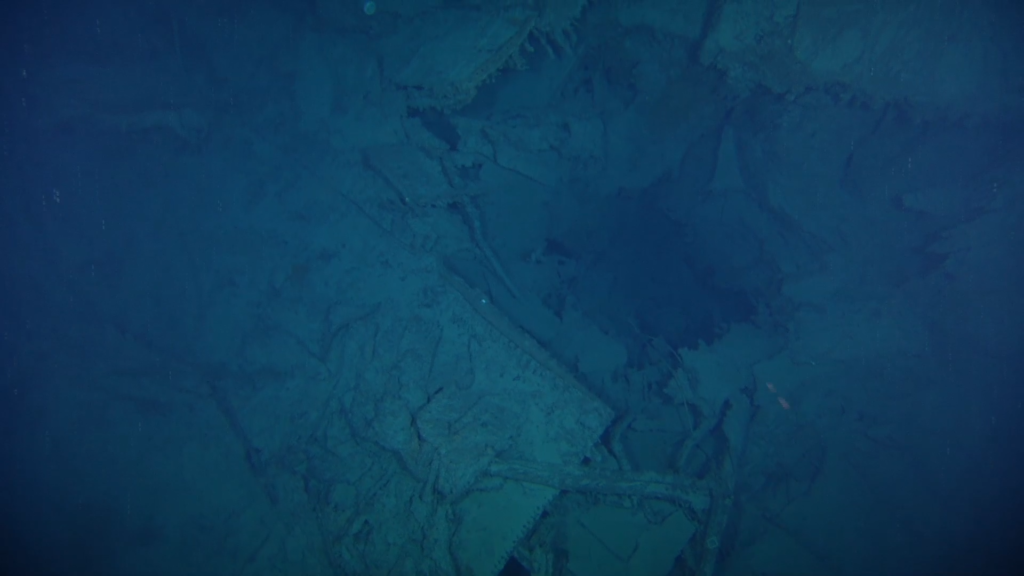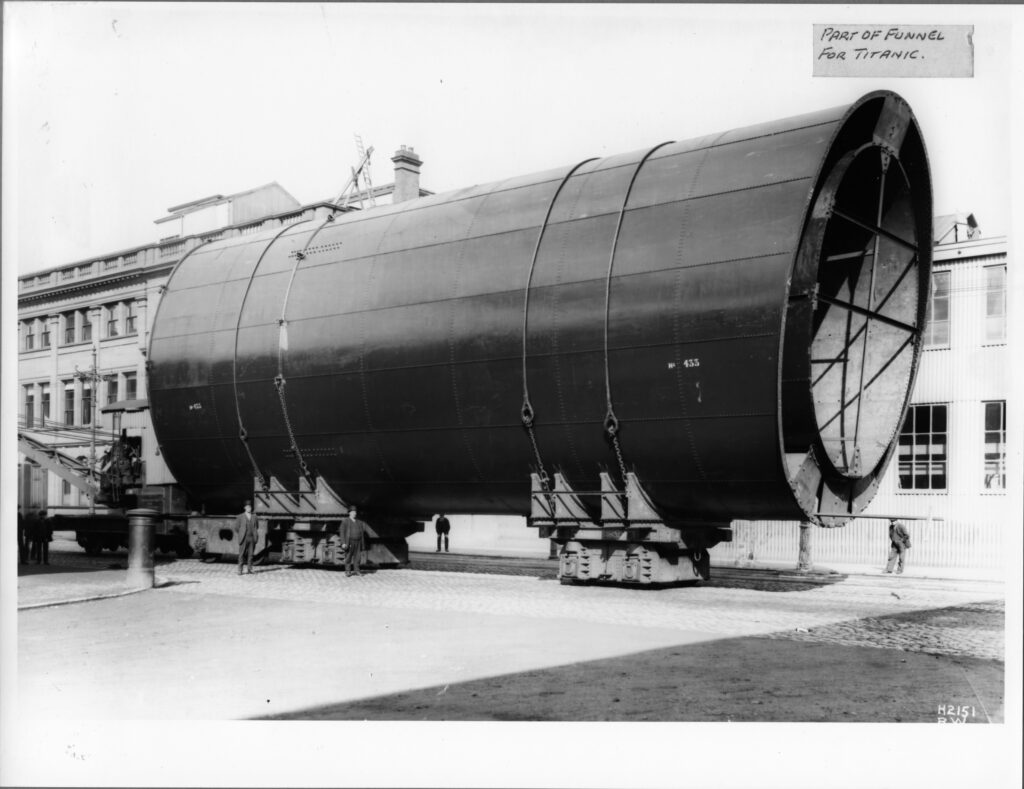Wreck Thursday – The Funnels

Wreck Thursday – The Funnels On Tuesday, we took a look at Titanic’s four majestic funnels, their design, and the way all four of them provided ventilation to various spaces throughout the ship, from the boiler rooms to the galleys and beyond. During the sinking, Titanic’s funnels collapsed, either sinking on their own or being pulled down by the wreck itself. The collapse of the first funnel, depicted in countless films, was a key moment in the ship’s final plunge. But what happened next? Titanic’s funnels, along with her masts and rigging, were among the items that originally concerned the team lead by Robert Ballard and Jean-Louis Michel when they decided to use the towed sled Argo to film the wreck once it was discovered in 1985. If Argo had been too close to the decks, it might collide with the ship’s funnels or get stuck in the rigging. Fortunately for the explorers, the funnels were nowhere to be found and the ship’s masts had both collapsed. The funnels, made of relatively thin metal, had not survived intact. Instead, the pressure of the ocean had flattened them down, and much of their metal had corroded into barely-recognizable forms. Due to the extensive mapping of the wreck and the debris field, however, what remains of the funnels, not to mention to tubing, whistles, and ladders that once adorned them, has been found, photographed, and, in some cases, recovered. Let’s now take a tour of the images to see what remains of these once-beautiful and iconic funnels. First, in a 2001 image, we see the remains of one of the steam pipes that had allowed for an emergency release of steam pressure. This would’ve been on the forward or aft part of one of the funnels. Perhaps more interesting, however, are the remains of one set of Titanic’s working whistles. A set of the ship’s whistles were recovered in 1993 by RMS Titanic Incorporated (RMSTI). We will discuss these in a future post. In the next image, from 2003, we can see the gaping hole where the first funnel once stood. The violence with which this funnel collapsed during the sinking is evident from the torn remains of the stack in the center of the image, as well as the twisted piping near the bottom of the image. Hauntingly in the third image, also from 2003, we can see one of the escape ladders inside the uptake for the first funnel. Available as a pathway for personnel from the ship’s boiler rooms to escape to the upper decks in an emergency, we’re left to wonder if this ladder provided salvation for any of the few who escaped the ship’s lowest decks. In the fourth image, again from 2003, we can see a close-up of the twisted and broken steam pipe from the second image. This is even more evidence of the way in which the first funnel fell into the sea. In the fifth and sixth images, we’re still looking at the area around the first funnel, this time at the space just in front of it. The grate in the foreground covers the Fidley trunk. This open space forward of the stack would’ve provided ventilation to the boiler room below, as well as having space for the escape ladders we mentioned earlier. In the seventh image, we’ve moved aft to the crumbled remains of the base of the second funnel. Here, we get some idea of the subdivision within the funnel itself that was mentioned on Tuesday. Other, smaller pieces of the funnels have been found in the debris field around the wreck, including flattened remains of the funnels themselves and much of the piping that was once visible on the aft side of the third funnel. As new images come to light and are analyzed, we will hopefully be able to continue to piece together the final journey and status of what were once the ship’s most recognizable external feature. Content: Nick DewittImages: 2001 Telegraph2003 NOAA2010 NOAA https://www.youtube.com/watch?v=l0v1d1kZxqE The footage above was released from the 2022 dive (Oceangate) by CBS in November of 2022.
Titanic Tours – The Funnels

Titanic Tours – The Funnels Photographs of a profusion of colorful funnels poking above the piers of New York Harbor are some of the most well-known images of the era of the luxury liner. A ship’s funnels, while an extremely functional necessity in most cases, can also become iconic, immortalized as baubles for passengers to purchase. Today, these are highly sought-after collectibles. Funnels are not a purely visual element of a ship, however. While the look and number of funnels can sometimes be put down to a stylistic choice, funnels came into existence and have remained a key component of non-nuclear ships for an important reason: to vent the gasses, cinders, and smoke generated by a ship’s engines up and away from the decks and the passengers and crew who roamed them. The history of liners is peppered with examples of ships, such as Norddeutscher Lloyd’s Bremen and Europa, that had their funnels made taller when the too-squat models initially fitted failed to do this basic task well. Titanic, as readers probably are aware, had four funnels atop her superstructure. Each of these were oval shaped, measuring 24’ 6” in diameter running fore to aft and 19’ in diameter running port to starboard. While they were level with one another at the top, the uneven height of the deckhouses above the boat deck meant that they rose to various heights, from 70’ for the first funnel to 73’ for the fourth to 74’ for the second and third funnels. The funnels were raked gracefully back, both for style and function, and, unlike the Cunarders Lusitania and Mauretania, spaced evenly and widely along the superstructure. This gave the Olympic-class ships a more yacht-like, graceful appearance than the greyhound racer profiles of the Cunarders. The funnels were also where the ship’s whistles were located, mounted on the forward side of each funnel. These were reached by a ladder that ran up the front of the funnel. Only the whistles on the first and second funnels were operational, those on the third and fourth funnels being purely decorative to ensure all four funnels looked uniform. Copper steam escape pipes ran up the fronts and backs of each funnel as well. It was from these pipes on the night of 14 April 1912 that steam loudly escaped as the liner came to her final stop, temporarily deafening those on deck. Funnel colors were important for identifying a ship with her company. As the shipping world expanded, each line developed their own color scheme. The White Star Line had adopted an 18’ tall black band at the top with the rest of the funnel painted in a color known as “White Star Buff.” The exact shade of this color will probably never be known for certain, and is believed to have varied somewhat from painting to painting and throughout the company’s existence. While model makers and artists make their own choice as to how best to represent this color in their creations, the easiest way to describe the color is as a pale orange-yellow. Researcher Robert Read has done an authoritative article on the likely formulations of this color which is linked below for those interested. The exterior, however, is only a small piece of the story here. The funnels each served various functions for the ship, entailing a varied structure inside each. The exterior tube that can be seen is actually fitted over and connected to an internal tube. This tube was the “working” part of the funnel, designed to conform to the job it was expected to perform. The first three funnels performed the expected function of funnels everywhere: venting the exhaust gasses and cinders from the ship’s six boiler rooms, with each funnel servicing two of these spaces. Each of these sets of boiler rooms comprised a different amount of fire grate area (the space in which the coal was actually burned to power the ship), so each funnel had a slightly different design. Each boiler’s uptakes stretched toward the center of the ship, where they gradually combined to be vented up through that funnel. The ship’s fourth funnel has been the source of much confusion over the years. While it is true that only the first three funnels were required for the Olympic-class liners to operate, this fourth iteration did serve in important ways. From a decorative perspective, the fourth funnel conveyed the idea of power and size to a traveling public that had become accustomed to the biggest and fastest ships sporting four funnels. It also allowed for a balanced look, with four funnels spacing evenly along the ship’s profile in a way that would not have been possible with just three. If it had stopped there, perhaps the fourth funnel could be put down as a true “dummy.” It could be considered as little more than an ornament added for aesthetic reasons only. This funnel, however, had a functional purpose as well. While not required for the ship’s boiler rooms, the fourth funnel provided ventilation for exhaust from the ship’s galley spaces, the extra tariff restaurant on B deck, the first class Smoking Room, the Turbine Engine Room, and various other spaces throughout the ship. While these spaces could possibly have been ventilated through other methods, being able to combine them into a funnel was much more effective. Each funnel was held in place by 12 stays or shrouds, each measuring 4” in circumference and with six located on each side of the funnel. These were secured at the base of the black-painted part of the funnel at the top and to various pad eyes on the deck at the bottom. Further Reading: Robert Read’s research on White Star Buff can be found here: http://www.titanic-cad-plans.com/whitestarbuff.pdf Content by: Nick Dewitt Funnel Installation This photograph of one of Titanic’s funnels before installation shows the way in which the funnel structure was subdivided and supported. Olympic’s Boat Deck This photograph from Olympic shows how the shrouds attached to both the upper

